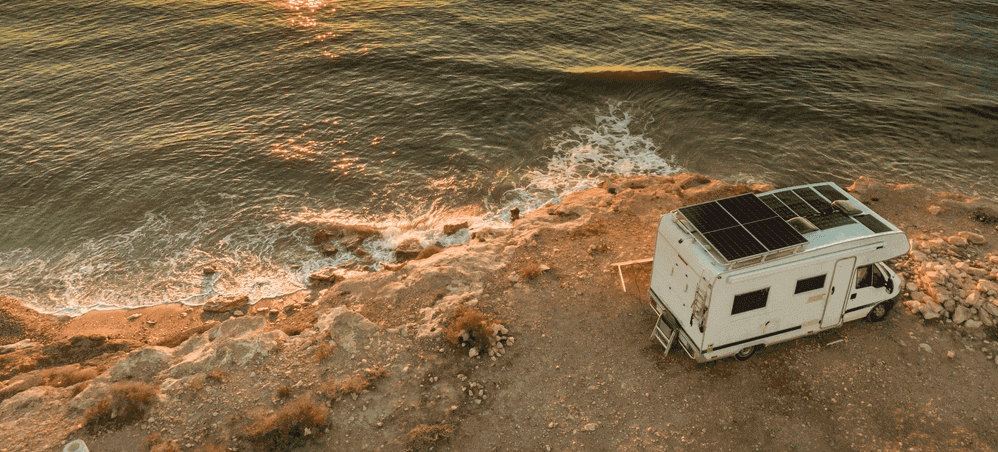In this report, Canstar Blue discusses different environmentally friendly ways to both connect with nature and enjoy as many safety tools and creature comforts as needed.
There is something unique about disconnecting from seemingly endless responsibilities, obligations or chores that are part of life. Once the fantasy of living like TV personalities from Alone, Survivor or Love Island wears off, turning on lights after dark, cooking a quick meal, having a cold drink and recharging a mobile phone might seem very appealing.
Fortunately, harnessing sunlight can generate clean energy that powers almost every kind of small appliance that can turn rustic living conditions into more creature comfortable habitats.
On this page:
- Which solar panels are best for camping?
- What are the best solar panel brands for camping?
- Where to buy solar panels for camping
- What solar panel wattage is recommended?
- Can a solar panel power a camping fridge?
- Are portable solar panels waterproof?
- How should solar panels be fitted?
- How much do camping solar panels cost?
- Are solar panels for camping worth it?
A variety of solar panels are designed for camp use and available from most hiking and other outdoor recreation stores. Additional items may be required including a solar regulator, battery storage and possibly an inverter, depending on which appliances need to be used.
Which solar panels are best for camping?
Monocrystalline are arguably the most common type of portable solar panels. Their pure silicon materials boast higher efficiency and power generation per square metre than other types of panels according to the Redarc Group website. Three options exist (including monocrystalline) and are listed below:
Monocrystalline: These are the most popular option for camping because they are highly efficient, able to charge batteries and – depending on their capacity – charge a number of small appliances.
Polycrystalline: Although these panels are claimed to be less efficient, they can work better than monocrystalline cells in low light and are generally cheaper than other alternatives. Because they charge slowly, they can be less reliable than other panels.
Thin film: These panels are thin and pliable. However, their convenience is also thought to bring a lack of efficiency. These panels are only able to power gadgets and small tech gear.
Compare solar deals
Here are some of the cheapest solar-specific deals from the retailers on our database. These costs are based on the Ausgrid network in Sydney but prices will vary depending on your circumstances. We show one product per retailer, listed in order of lowest price first. Annual price estimates assume general energy usage of 3900kWh/year for a residential customer on a single rate tariff. Price estimates exclude solar feed-in tariff credits. These are products from referral partners†. Our database may not cover all deals in your area, and please check retailer websites for up to date information.
Here are some of the cheapest solar-specific deals from the retailers on our database. These costs are based on the Citipower network in Melbourne but prices will vary depending on your circumstances. We show one product per retailer, listed in order of lowest price first. Annual price estimates assume general energy usage of 4000kWh/year for a residential customer on a single rate tariff. Price estimates exclude solar feed-in tariff credits. These are products from referral partners†. Our database may not cover all deals in your area, and please check retailer websites for up to date information.
Here are some of the cheapest solar-specific deals from the retailers on our database. These costs are based on the Energex network in Brisbane but prices will vary depending on your circumstances. We show one product per retailer, listed in order of lowest price first. Annual price estimates assume general energy usage of 4600kWh/year for a residential customer on a single rate tariff. Price estimates exclude solar feed-in tariff credits. These are products from referral partners†. Our database may not cover all deals in your area, and please check retailer websites for up to date information.
Here are some of the cheapest solar-specific deals from the retailers on our database. These costs are based on SA Power network in Adelaide but prices will vary depending on your circumstances. We show one product per retailer, listed in order of lowest price first. Annual price estimates assume general energy usage of 4000kWh/year for a residential customer on a single rate tariff. Price estimates exclude solar feed-in tariff credits. These are products from referral partners†. Our database may not cover all deals in your area, and please check retailer websites for up to date information.
What are the best solar panel brands for camping?
Some of the more popular brands offering portable solar panels for camping in Australia include:
- Knog
- Renogy
- EcoFlow
- Enerdrive
- Hard Korr
- Wanderer
- Goal Zero
- Aims Power
- Aussie Traveller
- Adventure Kings
- KickAss Products
- XTM 4×4 Accessories.
Where to buy solar panels for camping
Online retailers stock portable solar panels but very few supply them. Those who prefer browsing merchandise in bricks and mortar stores before making a purchase decision can consider visiting the following locations:
- Anaconda
- Hard Korr
- Tentworld
- Beacon Lighting
- 4WD Supacentre
- Bunnings Warehouse
- BCF.
Advertisement
What solar panel wattage is recommended?
Solar panel wattage will depend on what kind of power is needed at your camp. Canstar Blue has provided the below rough buyer guide for different electricity needs.
| Trip type | Appliances powered | System size |
|---|---|---|
| Short, infrequent trips | Phones, lights, tablets | 10W, 12V system. Consider using a powerbank to store energy |
| Regular camper | Phones, lights, kettle, fridge, cooking appliances | At least 100W, 12-24V. A small battery of at least 50-75Ah is recommended |
| Nomad | Phones, lights, kettle, fridge, portable aircon, hair dryers and more | 200W+ solar panels, 12-24V. Batteries of 150Ah or more are recommended |
Can a solar panel power a camping fridge?
Certain solar installations are claimed to supply enough energy for a small camping fridge. Some retailers offer camping fridges, batteries and solar panels in a single package. If you have no plans to buy a bundle, remember to consider the type of solar panel and wattage.
Are portable solar panels waterproof?
Good quality solar panels, batteries and other accessories are usually designed to be waterproof. However, checking with suppliers before storing them outside in the elements is recommended.
How should solar panels be fitted?
Converting sunlight into energy that is suitable for charging appliances requires solar panels, a regulator, battery, inverter and/or 12 volt outlets.
Solar panels must be connected to a regulator that feeds electricity into a battery and automatically prevents overcharging. An inverter converts 12V power to a suitable voltage for appliances and skipping this step requires buying a camping fridge and other elements with 12V by default.
How much do camping solar panels cost?
Different sizes and types of portable solar panels vary greatly in price. They can cost as little as $150 for small wattage up to $7,000 for good quality, high-end panels. As a general rule, covering basic solar powered charging and power supply needs could set you back by between $150 and $500.
Are solar panels for camping worth it?
Your camp location will help determine whether solar panels are essential. Tourist or holiday parks usually have power outlets and visitors do not require their own energy source. However, solar panels can offer extra comfort during off-grid adventures, especially when travelling for lengthy periods of time.
Image source: Voyagerix/shutterstock.com




Share this article